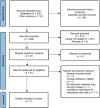Sleep duration is associated with metabolic syndrome in adolescents and children: a systematic review and meta-analysis
- PMID: 37185064
- PMCID: PMC10545995
- DOI: 10.5664/jcsm.10622
Sleep duration is associated with metabolic syndrome in adolescents and children: a systematic review and meta-analysis
Abstract
Study objectives: Studies on the associations between sleep duration and metabolic syndrome in adolescents and children have reported mixed results. To shed more light on this issue, we conducted this meta-analysis by synthesizing the results of previous studies.
Methods: Studies were retrieved from PubMed, Ovid, Cochrane, and Embase from inception to October 2021. Fixed-effects models and random-effects models were used to analyze the effects of sleep time on metabolic syndrome in adolescents.
Results: Data from 7 studies, including 13,305 adolescents and children, were meta-analyzed. Compared with the control group, short sleep durations were not associated with a high prevalence of metabolic syndrome in adolescents and children using a random-effects model (odds ratio = 0.92, 95% confidence interval = 0.48-1.37, I2 = 56.5%, P = .378). Using a fixed-effects model on long sleep duration, this association was statistically significant (odds ratio = 0.57, 95% confidence interval = 0.38-0.76, I2 = 0.0%, P < .001) as a protective factor compared with shorter sleep duration.
Conclusions: Long sleep duration, instead of short sleep duration, was significantly associated with a lower prevalence of metabolic syndrome among adolescents and children.
Citation: Xu Y, Hua J, Wang J, Shen Y. Sleep duration is associated with metabolic syndrome in adolescents and children: a systematic review and meta-analysis. J Clin Sleep Med. 2023;19(10):1835-1843.
Keywords: adolescents; meta-analysis; metabolic syndrome; sleep duration.
© 2023 American Academy of Sleep Medicine.
Conflict of interest statement
All authors were involved in writing the paper and have seen and approved the manuscript. This study was funded by the National Natural Science Foundation of China (Project No. 81973143). The authors report no conflicts of interest.
Figures



References
-
- National Cholesterol Education Program (NCEP) Expert Panel on Detection, Evaluation, and Treatment of High Blood Cholesterol in Adults (Adult Treatment Panel III) . Third Report of the National Cholesterol Education Program (NCEP) Expert Panel on Detection, Evaluation, and Treatment of High Blood Cholesterol in Adults (Adult Treatment Panel III) final report . Circulation. 2002. ; 106 ( 25 ): 3143 – 3421 . - PubMed
-
- de Ferranti SD , Gauvreau K , Ludwig DS , Neufeld EJ , Newburger JW , Rifai N . Prevalence of the metabolic syndrome in American adolescents: findings from the third National Health and Nutrition Examination Survey . Circulation. 2004. ; 110 ( 16 ): 2494 – 2497 . - PubMed
-
- Cook S , Weitzman M , Auinger P , Nguyen M , Dietz WH . Prevalence of a metabolic syndrome phenotype in adolescents: findings from the third National Health and Nutrition Examination Survey, 1988-1994 . Arch Pediatr Adolesc Med. 2003. ; 157 ( 8 ): 821 – 827 . - PubMed
-
- Pirkola J , Tammelin T , Bloigu A , et al. . Prevalence of metabolic syndrome at age 16 using the International Diabetes Federation paediatric definition . Arch Dis Child. 2008. ; 93 ( 11 ): 945 – 951 . - PubMed
Publication types
MeSH terms
LinkOut - more resources
Full Text Sources
Medical

